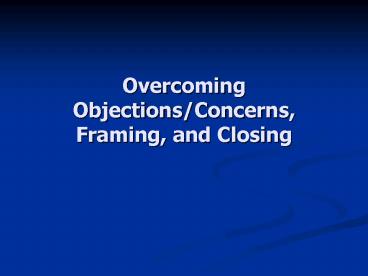Overcoming ObjectionsConcerns, Framing, and Closing - PowerPoint PPT Presentation
1 / 15
Title:
Overcoming ObjectionsConcerns, Framing, and Closing
Description:
Welcome objections no objection, no deal. ... A frame is the instantaneous, automatic reaction and picture your brain has to a ... – PowerPoint PPT presentation
Number of Views:36
Avg rating:3.0/5.0
Title: Overcoming ObjectionsConcerns, Framing, and Closing
1
Overcoming Objections/Concerns, Framing, and
Closing
2
Overcoming Objections/Concerns
- Welcome objections no objection, no deal.
- If prospects werent interested, they wouldnt
bother to object. - Figurative and literal objections
- Figurative are not real objections they are
negotiating tactics and should be dealt with as
such. - Literal objections are real and must be addressed.
3
Overcoming Objections/Concerns
- Probe to understand.
- Compliment, restate, and get agreement.
- Im glad you brought that up.
- You believe the company is not stable enough.
- Is that right?
4
- Empathize, reassure, and support (feel, felt,
found). - I understand how you feel.
- Other people have felt the same way at first.
- But they found when they dug into the details
that the company has 50 million in the bank from
two investment rounds and that some of the
savviest investors in the country are committed
to it. Plus, Google has already expressed
interest in acquiring it.
5
Tactics
- Forestall objections/concerns before they come
up. - Use Yes, and and compare.
- Use case histories.
- Pass on objections if they are figurative.
- Use trial closes.
6
Forestall Objections/Concerns
- Anticipate objections/concerns and deal with them
early in your presentation. - Frame offers according to personal needs of the
candidate.
7
What Is a Frame?
- A frame is the instantaneous, automatic reaction
and picture your brain has to a word or concept. - Dont think of an elephant.
- We lose when we miss free throws.
- We win when we make free throws.
8
Framing Example
- You have a serious heart disease and get two
doctors opinion on having an operation. - Doctor A says, Of 100 patients who have this
operation, 90 are alive after five years. - Will you have the operation?
- Doctor B says, Of 100 patients who have this
operation, ten are dead after five years. - Will you have the operation?
Richard H. Thaler and Cass R. Sunstein. (2008).
Nudge Improving Decisions About Health, Wealth,
and Happiness. New Haven Yale University Press.
9
- Frame your offers using one or more of the six
universal principles of social influence - Reciprocation (We feel obligated to return
favors.) - Authority (We look to experts to show us the
way.) - Commitment/consistency (We want to act consistent
with our commitments and values.) - Scarcity (The less available a resource, the more
we want it.) - Liking (The more we like people, the more we want
to say yes to them.) - Social proof (We look to what others do to guide
our behavior.)
Robert Caldini with Noah Goldstein, Steve J.
Martin. (2008). Yes! 50 Scientifically Proven
Ways to Be Persuasive. New York Free Press.
10
Frame Based on Personal Needs
- See List of Human Needs.
- See Benefits Matrix.
- To those who are competitive and like to win,
frame as a big win. - For those who are afraid to lose (losses loom
twice as large as gains to most people), frame as
a possible loss emphasize the pain and shame of
losing.
11
Tactics
- Use Yes, but and compare.
- Agree and then compare to alternatives.
- Use case histories.
- Examples of successes
- Pass on objections if they are figurative.
- Use trial closes.
- ABC (Always be closing.)
12
Trial Closes
- The Assumption Close
- The Choice Close
- The Minor-Point Close
- The Standing-Room-Only (SRO) Close
- The T-Account Close
- The Pin-Down Close
- The Clincher Close
13
Conditions
- Conditions
- Cant be overcome they are legitimate reasons
for not agreeing. - Keep the relationship.
14
Summary
- Welcome objections.
- Probe to understand.
- Use trial closes.
- Theyll be back.
15
Homework
- Read Chapter 11 Presenting, Media Selling, 4th
Edition - http//www.charleswarner.us/indexppr.html
- Review this presentation
- http//www.charleswarner.us/indexpresentions.html
- See Overcoming Objections, Framing, and Closing.































